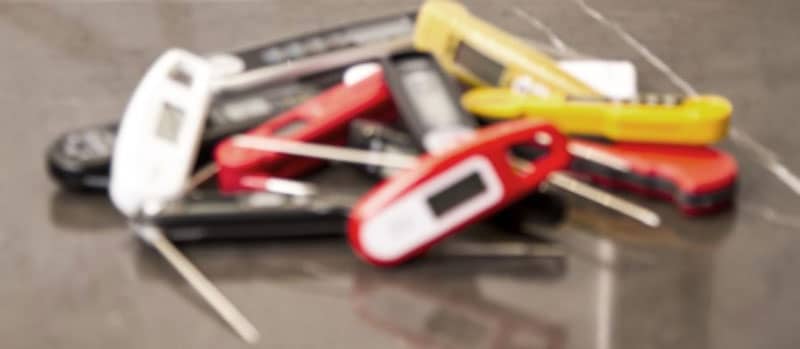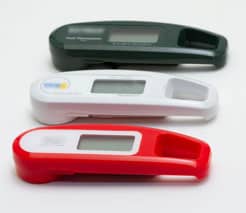
Five Signs You Bought the Wrong Thermometer
When you’re in the market for a food thermometer, how do you know which one to buy?
Some companies have gotten very good at packaging their inferior products to look like the best products. How do you know you’re spending your money on quality and not just marketing?
Here are five warning signs to look for when thermometer shopping. Each of these is a red flag that you’re about to buy an inferior product, and probably pay too much for it.
Warning Sign #1: The Packaging Or Marketing Doesn’t Tell You What The Sensor Type Is.
There are four major types of thermometer sensors (with many different grades of quality in each):
a. Mechanicals (like bi-metal springs and expanding liquids)
b. Thermistors (measuring changes in electrical resistance in a semiconductor)
c. RTDs (measuring changes in electrical resistance in metal)
d. Thermocouples (measuring changes in voltage between two alloy wires)
Each sensor type has its own advantages and disadvantages. Mechanicals are super cheap and super inaccurate. RTDs can be very accurate initially, but they’re fragile and easy to damage. Thermistors have good accuracy and are affordable, but are susceptible to physical shocks and prone to inaccuracy over time. Thermocouples can be very fast, very accurate, and the most durable, but they can cost a little more.
Thermometer packaging that doesn’t specify what type of sensor the thermometer uses often means that it is being marketed as something it is not. One notable thermometer webpage boasts that it includes an “ultra-sensitive Japanese sensor,” which is disingenuous marketing-speak for not telling you what you’re buying, a thermistor. It’s a warning sign when a company doesn’t give you the critical facts before you buy.
Warning Sign #2: You Paid More Than $40 For A Thermistor.
Very few food thermometer companies offer thermocouple or RTD sensors—at least, good ones. Thermistor sensors are by far the most common. And yet, some thermometer companies charge as much as $58 for thermistor technology. That is too much. With the exception of very specialized laboratory thermistors that costs hundreds or even thousands of dollars, even high-performance thermistors like the ThermoWorks ThermoPop (accurate to ±1.8°F in 3-4 seconds) cost less than $35. If you are buying a “high-performance Japanese sensor” (or any other kind of thermistor thermometer) for more than $40, you’re paying too much.
Warning Sign #3: The Company Doesn’t Include A Formal Specification Table.
A spec table lists a given thermometer’s verified performance across a range of performance factors including:
- Accuracy, usually expressed as “plus or minus” a certain range of error
- Speed, how quickly it gets to a reading within the accuracy spec
- Range, expressed as the lowest and highest temperature it can measure accurately
- Waterproof rating, expressed as a two-digit IP number
- Battery life, expressed as a number of hours of operation before replacement
Other specs, such as weight and size, can be listed, too. Quality thermometer webpages and packages should always list expected performance in these basic areas. If not, it’s a red flag that you’re probably about to overpay for an inferior product.
Some companies even go the extra mile and have their specs independently verified by instruments traceable to national standards and maintained in an internationally accredited calibration laboratory. Actually, only one company does that. You can guess which one.

Warning Sign #4: The Thermometer Body Shape Is Not Unique.
Unlike professional thermometer companies that engineer and manufacture their own designs, many cheap-o “housewares” companies simply acquire a pre-built body or pre-built circuitry (or both) from bulk manufacturers (mostly in China).
If you see another thermometer from a different brand that looks exactly like your thermometer, you probably spent too much on it. These pre-built bodies and circuit boards are very inexpensive and usually have a lot of markup.
Warning Sign #5: The Company Doesn’t Seem To Have A Physical Location Or A Phone Number.
No matter which thermometer you buy, there’s always a chance something will go wrong. If you buy a $15 thermometer, you can expect to just throw it away when it starts acting funny (which, given the atrocious performance of those models—±10°F in 30 seconds or so—really starts with day one). But if you pay more than $30 for a thermometer, you should be able to talk to the company that manufactured it if something doesn’t make sense.
Look carefully at the box your new thermometer came in. If it doesn’t have a phone number or physical address printed on it, then to whom are you entrusting the safety and quality of your food?! Don’t settle for a cheap knock-off from a “virtual” company with a pretty website.
Conclusion
This holiday season, know the warning signs. Make sure your hard-earned money gets spent on a quality thermometer that will last for years and consistently give you speedy, accurate readings. Remember to make sure to verify…
- that the sensor type is clearly stated
- that you’re not paying more than $40 for a thermistor sensor
- that the website and packaging list critical performance specs such as accuracy, speed, and range
- that the body-shape is unique and not a copy
- and that there is a phone number and physical address listed on the website and package
Stay tuned for our upcoming post: “Why the $99 Thermapen Mk4 Is Worth Every Penny.”
